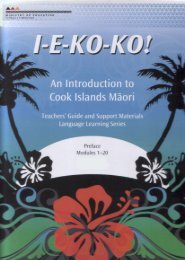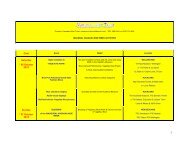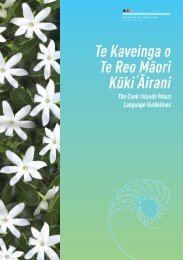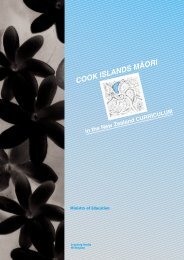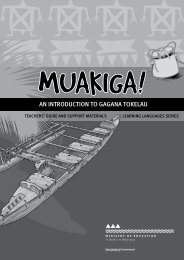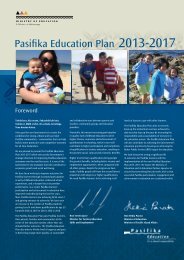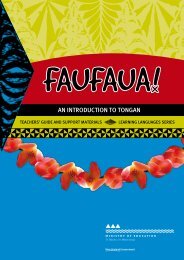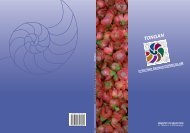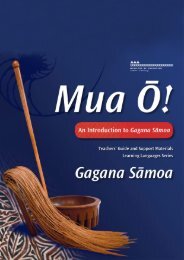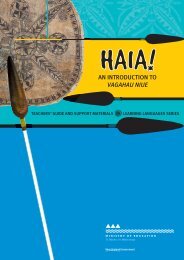Vāega 1: ‘O ni fa‘ata‘ita‘iga i <strong>le</strong> aganu‘u fa‘asā<strong>mo</strong>aLevel 1: Suggested aspects of fa‘asā<strong>mo</strong>aFamilies provide their children with a set of beliefs, behaviours, and cultural understandings.Students bring to their <strong>le</strong>arning diverse cultural values based on their family backgrounds and lifeexperiences. In school settings, connections need to be made between the diverse cultural experiencesof students and the cultural values and practices of aganu‘u fa‘asā<strong>mo</strong>a. The experiences of somestudents will include aspects of traditional practices, such as weddings or cooking food, as well asaspects of contemporary influences.The tab<strong>le</strong> below suggests possib<strong>le</strong> aspects of aganu'u fa'asā<strong>mo</strong>a for the Cultural Know<strong>le</strong>dge strandat <strong>le</strong>vel 1.Atamai i <strong>le</strong> Aganu‘uCultural Know<strong>le</strong>dgeStudents will:‘O ni fa‘ata‘ita‘iga i <strong>le</strong> aganu‘u fa‘asā<strong>mo</strong>aSuggested aspects of fa‘asā<strong>mo</strong>aStudents could be <strong>le</strong>arning through experiences that allow them to:52• position themselves appropriatelywhen relating to others;• recognise and express fa‘aaloalo in avariety of contexts;• respond to and use gagana Sā<strong>mo</strong>atexts;• participate in a simp<strong>le</strong> culturalperformance;• make connections with knownculture(s).• take the appropriate position (with head bowed, eyes down, andcrouching) when speaking to a teacher or elder and say, “Tuloulava lau susuga”;• walk behind an older person (savali i tua);• sit down before talking to an adult (nofo i lalo pe‘ā tautala i ai);• use classroom greetings such as Tālofa lau susuga i <strong>le</strong> faiā‘oga;• thank an adult, for examp<strong>le</strong>, by saying Fa‘afetai i lau susuga …;• practise waiting for everyone, especially parents and elders,before eating;• attend to the grace said to b<strong>le</strong>ss the food before eating;• help with meal-related chores, such as getting the bowl andtowel for hand washing;• offer visitors hospitality;• engage with texts in gagana Sā<strong>mo</strong>a that include songs, poems,myths, and <strong>le</strong>gends;• discuss news, for examp<strong>le</strong>, on te<strong>le</strong>vision and radio and innewspapers;• perform, for examp<strong>le</strong>, in school Polynesian festivals and comedyshows such as fa<strong>le</strong>aitu;• read journals, for examp<strong>le</strong>, Fōlauga;• sing hymns, such as “Fa‘afetai i <strong>le</strong> Atua”, and songs, such as“Ie Lavalava Teuteu Fa‘asā<strong>mo</strong>a”;• tell myths and <strong>le</strong>gends, for examp<strong>le</strong>, about Sina and the Eel, Aloand the Tanifa, or ‘Apa‘ula and Vaea;• take part in sāsā and siva;• take part in simp<strong>le</strong> cultural practices, for examp<strong>le</strong>, greeting andthanking peop<strong>le</strong>;• compare the fa‘asā<strong>mo</strong>a way of preparing an umu with foodpreparation practices in other cultures;• compare fa‘asā<strong>mo</strong>a counting systems with those of othercultures.
Vāega 1: ‘O ni fa‘ata‘ita‘iga i <strong>le</strong> fa‘atinoga o a‘oa‘oga ma iloilogaLevel 1: Suggested <strong>le</strong>arning and assessment activitiesNot all of the following activities are suitab<strong>le</strong> for every age group. Teachers will se<strong>le</strong>ct those thatare appropriate, adjust a particular activity to suit the needs of their students, or make up their ownactivity appropriate to the objectives to be met. Some activities specific to cultural <strong>le</strong>arning are listedabove, under the heading Suggested aspects of fa‘asā<strong>mo</strong>a. It is also important to acknow<strong>le</strong>dge thecultural context present in all genuinely communicative activities so that students are supported asthey acquire the linguistic and the cultural know<strong>le</strong>dge and skills they need to communicate confidentlyand effectively with other speakers of gagana Sā<strong>mo</strong>a.<strong>Gagana</strong> fa‘alogo ma <strong>le</strong> tautalaOral language: Listening and speakingStudents could be <strong>le</strong>arning through:• distinguishing between the sounds of gagana Sā<strong>mo</strong>a and those of other language(s);• listening to short texts and identifying certain sounds, words, or phrases;• identifying <strong>le</strong>tter and sound combinations to indicate particular meanings, for examp<strong>le</strong>,luga and luma;• listening to simp<strong>le</strong> stories, poems, or songs and saying which they enjoy the <strong>mo</strong>st;• listening to simp<strong>le</strong> descriptions of com<strong>mo</strong>n objects, for examp<strong>le</strong>, items in the classroom, andidentifying these non-verbally, for examp<strong>le</strong>, by pointing to them or drawing them;• responding to requests for personal details, for examp<strong>le</strong>, name, age, address, or phone number;• taking turns to name com<strong>mo</strong>n objects, for examp<strong>le</strong>, peni, ‘api, ‘ato, potu;• taking part in short, contextualised conversations on a familiar topic, for examp<strong>le</strong>, discussingwhat they like and dislike;• giving and responding to simp<strong>le</strong> descriptions of themselves, family members, other peop<strong>le</strong>,or simp<strong>le</strong> objects, for examp<strong>le</strong>, ‘o <strong>le</strong> teine matua, ‘o <strong>le</strong> pūlou mūmū, ‘o <strong>le</strong> ‘api uliuli;• requesting that objects be given or handed to them, for examp<strong>le</strong>, ‘aumai lau peni, ‘ou te lēmālamalama;• responding appropriately to classroom language, for examp<strong>le</strong>, roll call, or questions;• ro<strong>le</strong>-playing introductions;• ro<strong>le</strong>-playing asking for and giving a name, address, and te<strong>le</strong>phone number.53<strong>Gagana</strong> faitau ma <strong>le</strong> tusitusiWritten language: Reading and writingStudents could be <strong>le</strong>arning through:• reading a range of simp<strong>le</strong> texts in gagana Sā<strong>mo</strong>a to extend their vocabulary know<strong>le</strong>dgeand interpret meaning;• reading gagana Sā<strong>mo</strong>a names (for examp<strong>le</strong>, at roll call, using a greeting and response –“Tālofa Sina”, “Tālofa lau susuga”) to develop their pronunciation accuracy;• reading short descriptions of familiar objects and matching the descriptions to pictures;• listening to each other speak gagana Sā<strong>mo</strong>a, writing down exactly what they hear withoutaltering the spoken text (for examp<strong>le</strong>, a simp<strong>le</strong> te<strong>le</strong>phone message), and then showing thewritten version to the speaker for verification;• recognising and producing sounds, <strong>le</strong>tters, and vowel combinations of the mata‘itusi o <strong>le</strong>gagana Sā<strong>mo</strong>a (Sa<strong>mo</strong>an alphabet);



